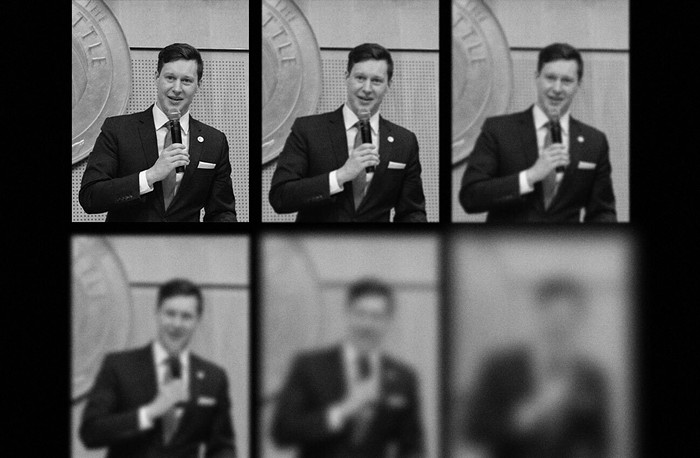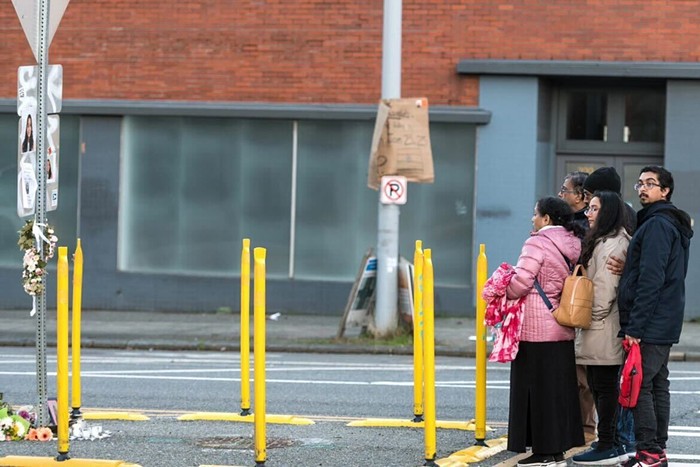Local politicians and activists agree: King County should eventually stop detaining youth. The Seattle City Council passed a resolution saying as much in 2015. King County executive Dow Constantine signed on to the vision in January.
The point of disagreement is over how quickly the criminal justice system can achieve Zero Youth Detention, a phrase popularized by local activists opposed to the planned construction of a new juvenile detention center. It's a classic debate between radical and incremental change, and it's the fundamental question behind the discourse over the new youth jail.
Proponents of the jail cite alarmingly violent crimes (think: rapes, murders, and armed robberies) to argue that eliminating youth detention won't be possible anytime soon. During an election endorsement meeting in June, for instance, Constantine pulled out his phone and rattled off the facility's daily population count: one rape, two murders, and 10 first-degree robbery charges. "The preponderance of these are stealing something from you with a weapon or worse," he said.
"Youth have to be detained if they shoot somebody, and the opponents still have no answer for that," said King County prosecuting attorney Dan Satterberg during a city council meeting in May. (Council members voted that day to compel a hearing officer to consider a review of the new jail's city permit, a victory for anti-jail activists.)
Opponents of the new detention center tend to focus on lesser offenses. Before she announced her run for mayor in March, Nikkita Oliver wrote an editorial for the South Seattle Emerald alongside Gyasi Ross arguing against building a new juvie and "filling it with non-violent juvenile offenders and youth who violate probation." As for violent offenders, the two attorneys wrote, "We need to figure it out."
What's missing is everything in between: burglaries, car thefts, and violent offenses that don't rise to the severity of rape or murder (think: low-level assaults or property damage). To truly understand what it would take to eliminate juvenile detention—precisely what crimes we would have to decriminalize or prevent entirely—it's worth looking at the numbers.
King County regularly publishes reports on data and trends at the juvenile lockup in the Central District. The general takeaway: Overall detention has shrunk dramatically over the past decade, but racial disproportionality in the system has worsened.
For example, the average daily population count at the youth jail has fallen from 94 in 2007 to 51 in 2016—a 43 percent drop. During the same time period, the percentage of detention bookings of black and Hispanic children rose from 61 percent to 70 percent, despite the two groups making up about 15 percent of the county's population.
But the data shared with the public over the years—the same data cited by defenders and opponents of the new youth jail alike—tells only a fraction of the story.
King County's regular reports do not break down bookings by charge. Rather, they divide charges into broad categories, including "person crimes," "property crimes," and "other." What's known as "person crimes" could range from school fights to murders. "Property crimes" could account for someone stealing candy or a car.
For clarity in the debate over the local juvenile justice system—a discussion that has moved from the streets to the council chambers to the mayor's race—The Stranger asked county justice officials to provide detailed booking data from 2010 to 2016. (We asked for data from 2010 onward because that is the year the county switched to a new system for recording bookings.)
We received a data set breaking down each admission by race, gender, age, charge, and length of stay. In total, the data set constituted more than 15,000 detention bookings at the King County Juvenile Detention Center.
Our report represents the first media analysis of juvenile detention in King County that categorizes bookings into precise criminal offenses.
As in any data analysis, the numbers come with caveats. The county's data does not account for unrecorded factors that could lead to detention. For example, minor offenses that typically don't lead to incarceration could still land a kid in jail if they were recently locked up for more serious crimes. Also, each data point represents a booking, not an individual, so the numbers shouldn't be taken to reflect how many kids went to jail over the six-year period.
Still, the data offers a longitudinal view of who generally gets locked up for what types of crimes. Taken as a whole, the data shows exactly in what areas city and county officials have made strides in reducing juvenile incarceration.
At the same time, it can be read as a road map outlining places where judges, prosecutors, and police officers need to focus their energy if they are seriously envisioning a future in which we stop putting kids in jail.
Tracing each charge tells a different story. Consider fourth-degree assault, the most commonly cited offense—about 17 percent in 2016—for juvenile detention bookings in King County. Unlike more serious assault charges, the offense is rarely committed with a weapon. Also, injuries resulting from the crime aren't life-threatening.
Reflecting the overall trend, bookings for fourth-degree assault dropped significantly since the turn of the decade, from 470 in 2010 to 246 last year. County officials cite myriad causes for the decline, including ramping up diversion programs and rethinking the consequences for lower-level crimes—all elements of a restorative, rather than punitive, approach to criminal justice.
Pulling back another layer shows that most of the charges for fourth-degree assault in King County, 70 percent in 2016, involve domestic violence. Justice officials say such charges most often involve parents calling the police on a child after he or she becomes violent.
Following the meeting with Dow Constantine, in which we raised the prevalence of fourth-degree-assault bookings at the juvenile jail, the county sent us another data report showing that there were 32 fewer fourth-degree domestic-violence assaults in the first three months of 2017, compared with the same time period in 2016.
County justice officials point to a recently implemented program called Family Intervention and Restorative Services for the drop. Known as FIRS, the diversion program specifically addresses children who commit domestic-violence offenses. Rather than incarceration, participants in FIRS go to a respite center in a converted jail wing with beds, a television, and a full-time staff. They're given time to cool off before county officials connect them with services.
Bookings for black and white juveniles charged with low-level assault fell at a similar rate, both groups seeing a drop near 50 percent from that time period. The same cannot be said for first-degree robbery and robbery attempts, charges that involve weapons, injuries, or financial institutions. Juvenile bookings for such crimes have actually grown over the six-year period, from 76 in 2010 to 102 in 2016. Robbery, looking at all its degrees of severity, represents the second most common category of charge leading to juvenile detention, making up about 12 percent of bookings in 2016.
It is consistently one of the biggest culprits for the racial disparity in King County's youth jail. In 2016, black youth made up about 65 percent of juvenile bookings for robbery.
Activists stress that historical injustices and institutional failures—disparities in housing, education, employment, and other factors—contribute to the robbery charges among youth of color. "If they're black and brown kids, we have to understand they're facing systemic racism every day," said Senait Brown, co-coordinator of End the Prison Industrial Complex, an activist group opposed to the new youth jail.
At the same time, King County justice system improvement manager David Chapman emphasizes that disproportionate bookings don't mean that black kids commit any particular crime at a greater rate. "From my experience, if you took a phone from another student or another person, that unconscious bias could make the threat greater if you're a person of color," he said.
What is clear is that any serious talk about reducing youth incarceration, particularly reducing the racial gap, must grapple with how the system should handle kids accused of stealing with the aid of weapons.
When asked how the county has tackled this problem, Constantine points to a pilot program called peacemaking circles, in which young offenders attend meetings with families of the victim, community groups, and victims' advocates to talk about the crime, how it affected each party, and how to heal.
King County handled its first felony case through a peacemaking circle in 2016, for a teen charged with robbing another teen using a BB gun. As of July 7, a youth charged with felony harassment had also completed the program. Two other youths, both charged with robbery offenses, are currently doing the program. Constantine has called for bringing this program "to scale," so it's available for "every youth for whom it is appropriate." But he has not specified how the county will pay for the program's expansion.
Looking at other charges points to more radical shifts in the county's thinking around juvenile justice. Consider prostitution. In 2010, the juvenile jail made 72 admissions for prostitution-related offenses, including 40 charges of prostitution and 32 charges of "prostitution loitering," a broadly defined offense that implicates anyone who appears to be soliciting or selling sex in a public place.
Beginning the next year, the county changed its thinking on prostitution. "We started looking at things through a brain-science lens and a harm-reduction lens. If you look at harm reduction, the boys and girls preyed upon need to get out of that industry. Prosecution for that offense is not the answer," said Chapman. The number of prostitution charges leading to detention started to drop precipitously, with a low point in 2016 of two cases.
County officials recently voted to remove prostitution from the list of charges considered "booking-eligible" offenses. Also soon to be removed from the list: second-degree vehicle theft, another offense disproportionately charged to black and brown youth. As opposed to first-degree vehicle theft, juveniles who commit this offense usually aren't the drivers, but passengers, in a stolen car.
Contrary to some of the county's messaging, the jail data belies an impression that kids aren't being locked up for minor and petty offenses.
For instance, 2016 saw 16 admissions for alcohol-related offenses, including minor in possession and public intoxication. Constantine's daily population snapshot did not include children booked on trespassing charges, an offense that led to 12 admissions into jail last year. Nor did the day's count include juveniles charged with third-degree theft, a gross misdemeanor that led to 43 youth detentions in 2016.
Ask county officials why kids are still being booked for underage drinking and petty theft, and they'll tell you that any one particular offense doesn't tell the whole story. "We like to say we don't lock up kids for minor offenses, and we really don't," says Paul Daniels, juvenile court services manager for King County.
Neither "minor in possession" nor "third-degree theft" appear on the list of offenses that automatically land a child in detention. However, should a juvenile get caught drinking beer or pocketing candy bars after getting released on more serious crimes, they could be headed for lockup. For example, all the juveniles booked for alcohol-related offenses in 2016 were either picked up on warrants or violating court-ordered probation.
Opponents of the new youth jail have specifically singled out probation violations as an area where the county could make steps toward reducing incarceration.
Data, of course, does not make policy. One thing is for certain: Targets for the detention side of the juvenile justice system can't be the end of the discussion. What booking data doesn't account for is children referred by police to King County prosecutors through arrests and summonses. Not every referral ends with incarceration, but most detained children get referred.
For Elizabeth Haumann Ford, a criminal justice researcher for the county, looking at referrals is key to tackling the problem of racial disparity in juvenile lockups. Who gets 911 called on them? Who gets stopped on the street by police?
"That's the front door of the system," Ford says. From 2013 to 2016, referrals to the King County juvenile justice system dropped nearly 17 percent. At the same time, referrals for white juveniles dropped at a far greater rate (about 28 percent) than blacks (about 3 percent).
As for the back door, Constantine says the reductions over time in the number of kids incarcerated are indications of progress, and diversion programs already in place, two of which are featured in this juvenile justice package, show a commitment to continuing that decrease. To get there, Constantine said in his state of the county address in March, the county needs "a plan."
"Shouting 'Zero Youth Detention' is not a plan," he said.
For activists against the new youth jail, however, looking at who gets booked into detention completely misses the point. "We're not trying to shift numbers around. We're trying to eliminate the system," said Brown. "If we're not headed toward eliminating youth prisons, anything they try to do will just be a Band-Aid. We'll just see the disparity pop up in another place."
Heidi Groover contributed reporting to this story.
More youth detention stories:
1. The Great Youth Detention Debate
2. What Will It Take to Stop Locking Up Kids?
Read next: 3. Judge Roger Rogoff Has the Power to Change a Kid's Life. But Does He Have the Tools?
4. Family Matters: First It Was a Jail Wing, Then It Became a Respite Center
6. Can the New Youth Jail Render Itself Obsolete?



















